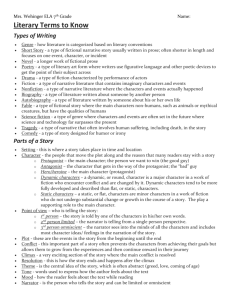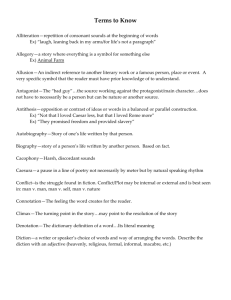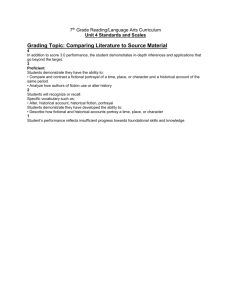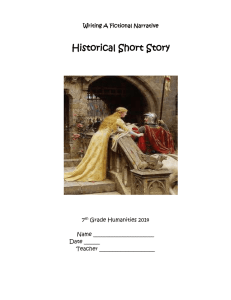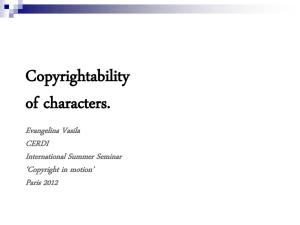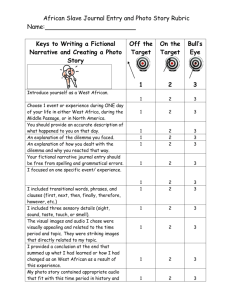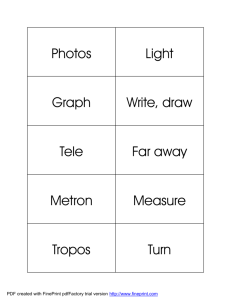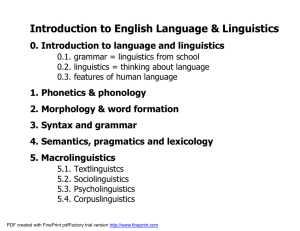(very short) Dictionary of English Literary Terms - Doktor
advertisement
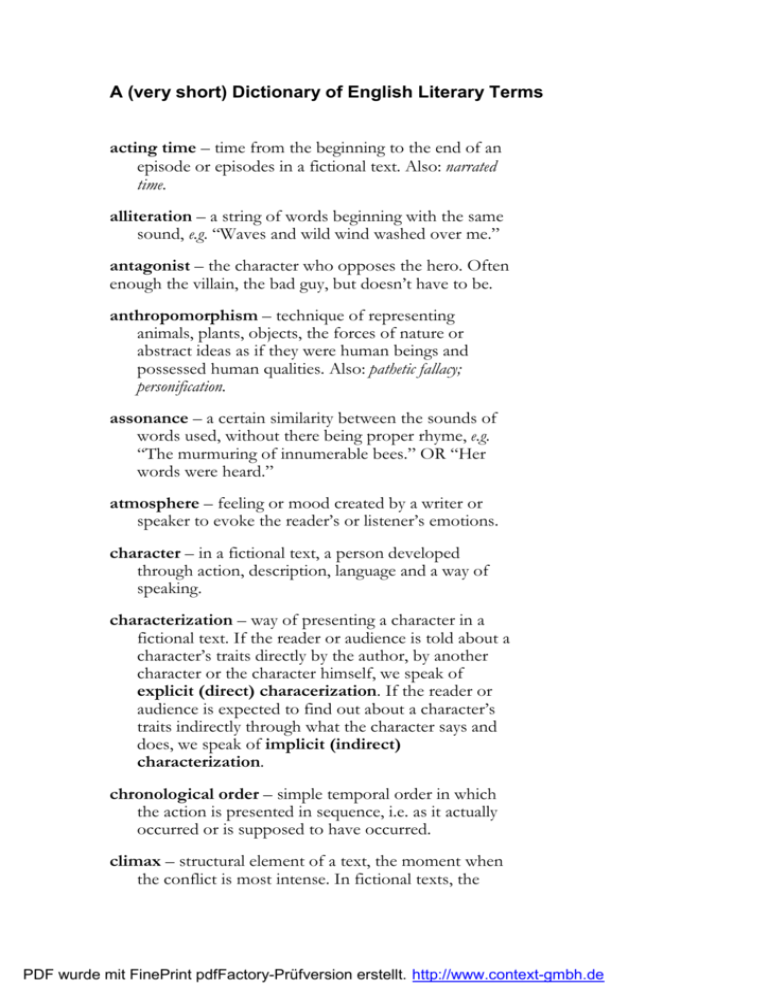
A (very short) Dictionary of English Literary Terms acting time – time from the beginning to the end of an episode or episodes in a fictional text. Also: narrated time. alliteration – a string of words beginning with the same sound, e.g. “Waves and wild wind washed over me.” antagonist – the character who opposes the hero. Often enough the villain, the bad guy, but doesn’t have to be. anthropomorphism – technique of representing animals, plants, objects, the forces of nature or abstract ideas as if they were human beings and possessed human qualities. Also: pathetic fallacy; personification. assonance – a certain similarity between the sounds of words used, without there being proper rhyme, e.g. “The murmuring of innumerable bees.” OR “Her words were heard.” atmosphere – feeling or mood created by a writer or speaker to evoke the reader’s or listener’s emotions. character – in a fictional text, a person developed through action, description, language and a way of speaking. characterization – way of presenting a character in a fictional text. If the reader or audience is told about a character’s traits directly by the author, by another character or the character himself, we speak of explicit (direct) characerization. If the reader or audience is expected to find out about a character’s traits indirectly through what the character says and does, we speak of implicit (indirect) characterization. chronological order – simple temporal order in which the action is presented in sequence, i.e. as it actually occurred or is supposed to have occurred. climax – structural element of a text, the moment when the conflict is most intense. In fictional texts, the PDF wurde mit FinePrint pdfFactory-Prüfversion erstellt. http://www.context-gmbh.de A (very short) Dictionary of English Literary Terms climax follows the rising action and precedes the turning point. conflict – clash between different forces. In fictional texts, the struggle may be one of ideas or values within a character (internal conflict) or between two characters or one character and fate/nature/society (external conflict). contrast – opposite or strongly contrasting forms of words. “I am going north by train; she is coming south by car.” dénouement – solution;.the final threads of the storyline woven together, or spun on so as to offer the reader a sense of continuity. deus ex machina – (‘god out of a machine’) In Greek theater a god that was lowered onto the stage from a scaffolding, making a divine ruling known. The term now describes any literary means beyond the logic of the plot/story itself, by which a sudden turning of events is achieved diegesis – the telling of a story, as opposed to the showing of a story (mimesis). Applicable to panoramic presentation. ellipsis – leaving out words to avoid repetition, e.g. “Caesar came, saw and conquered” instead of “Caesar came, then he saw and then he conquered.” emotive – using words or expressions which have particular connotations in order to appeal to the reader’s or listener’s emotions and influence him or her in some way. exposition – structural element of a fictional text, usually at the very beginning, including the introduction of the main character(s), the theme and the setting, as well as first indications of the atmosphere and tone. falling action – structural element of a fictional text, marked by a reduction of the suspense. It usually follows the turning point and precedes the solution. ficelle – [thread] character who appears throughout a fictional text in the most obscure places yet doesn’t PDF wurde mit FinePrint pdfFactory-Prüfversion erstellt. http://www.context-gmbh.de 2 A (very short) Dictionary of English Literary Terms have much to do with the action as such; often serves to describe the protagonist/antagonist implicitly. fiction, fictional – category of texts in which the author creates his or her own world. The readers or a audience are expected to accept this world as existing within the context of the text, even though it may be different from their own experience of reality (novels, short-stories, dramas and poems). flashback – interruption of the chronological order in order to go back in time and show what happened earlier. flat character – character who represents one attitude towards another character, a situation, a moral question – yet who is not developed and looked at from more than one point of view. Such a character doesn’t change. (See also: stock character; type.) foreshadowing – interruption of the chronological order in order to go forward in time and suggest things which may have a bearing on what is happening at the moment. hyperbole - a form of exaggeration, as in “That guy weighed at least a ton,” or “waves as tall as houses.” imagery – the use of metaphor(s) and/or simile(s); when the images evoked by such devices are interwoven, are connected and constitute a new layer of meaning, one talks of the imagery in a text. irony – to say one thing but mean another. Irony can usually only be detected from the context. If we say “what charming behaviour,” it would take rude behaviour to make the phrase ironic. (See also: sarcasm.) metaphor – an expression used to describe one thing comparing it/them directly with another thing, e.g. “School is hell for many pupils.” mimesis – the showing of a story, as opposed to the telling of a story (diegesis). Applicable to scenic presentation. PDF wurde mit FinePrint pdfFactory-Prüfversion erstellt. http://www.context-gmbh.de 3 A (very short) Dictionary of English Literary Terms narratable disequilibrium – one can only tell a story when something is not quite right, when there is something that can be told (unless one wishes to be utterly boring). As soon as the happy end is there, the story ends, nothing is left to be told. The solution to each and any problem within a story leads to nonnarratable stasis. narrated time - time from the beginning to the end of an episode or episodes in a fictional text. Acting time. narrating time – time it takes to relate a particuluar event or series of events in a narrative text, nearly the same as reading time. The relationship between narrating time/reading time and acting time is dependent on the mode of presentation. narration, narrative – one of the five text types, presenting actions or events in some kind of temporal orders. Can, but doesn’t have to be fictional. narrator – person who tells the story in a narrative text, through whose eyes events are seen. The narrator is usually not identical to the author. omniscient narrator – (all-knowing) a narrator whose scope of vision and knowledge is unlimited. onomatopoeia – words that sound like the thing they refer to, e.g. “buzzing bees,” “clanking, clanging chains,” or “a trickling creek.” open ending – structural element of a fictional text, the opposite of a solution: the conflict is not solved, the final interpretation is left up to the reader or audience. order – chronological, climactic, contrastive, dialectical, listing, temporal, topical order. parallelism – a string of sentences, clauses or phrases all with more or less the same structure, e.g. “The teachers tyrannized the pupils, the pupils tyrannized their parents, and the parents tyrannized the teachers by calling them at home.” pathetic fallacy – technique of representing animals, plants, objects, the forces of nature or abstract ideas PDF wurde mit FinePrint pdfFactory-Prüfversion erstellt. http://www.context-gmbh.de 4 A (very short) Dictionary of English Literary Terms as if they were human beings and possessed human qualities. Also: personification; anthropomorphism. personification – technique of representing animals, plants, objects, the forces of nature or abstract ideas as if they were human beings and possessed human qualities. Also: pathetic fallacy; anthropomorphism. plot – in fictional texts, the structure of the action as a set of events connected by cause and effect and centred around one or more conflicts. Plot is typically composed of the following elements, usually in this order: exposition, rising action, climax, turning-point, falling action, solution or open ending. Definition by E.M. Forster: “The King died and then the Queen died” – is a story (series of events). “The King died and then the Queen died of grief” – is a plot (sequence of events). point of view – relationship between the writer/narrator/speaker and his or her text; narrative perspective from which the topics/characters and events are presented. Point of view may be personal, i.e. in the first person (“I”, “we”) or non-personal, i.e. in the third person (“he”, “she”, “they”). If the writer/narrator/ speaker knows everything about the topics/characters and events, he or she is said to be omniscient, the point of view is unlimited. Otherwise the point of view is limited. A narrator may be limited omniscient, when he knows everything about one (or a small group of) character(s) but can only describe the actions and words of the other characters. (mode of) presentation – way in which events are related to the reader or listener in a narrative text. If a story is told as a condensed series of events, this is known as panoramic presentation; if an incident is shown in detail, we speak of scenic presentation. A text which shows us what is happening is called mimetic, one that tells us of things is called diegetic. A special kind of scenic presentation is interior monologue, i.e. the verbal reproduction of a character’s feelings, thoughts and recollections with no intervention by the narrator. The mode of presentation is closely related to an author’s treatment of time. PDF wurde mit FinePrint pdfFactory-Prüfversion erstellt. http://www.context-gmbh.de 5 A (very short) Dictionary of English Literary Terms protagonist – the character who is the hero, the good guy, or at least the character through whose experiences we see the whole story. The protagonist can be a bad guy, too. reading time – time it takes to read about a particular event or series/sequence of events in a narrative text, nearly the same as narrating time. The relationship between reading time/narrating time and acting time is dependent on the mode of presentation. rhetorical question – a question which expects no answer, e.g. “How long will this war last?” rising action – structural element of a fictional text, marked by an increase in the suspense and an intensifying of the conflict. It usually follows the exposition and precedes the climax. round character – character who is deeply looked into, looked at from various different angles, giving the reader different (and even conflicting) aspects of its personality. In the course of the narrative this character will change. sarcasm – saying one thing but meaning another AND intending this to hurt, e.g. “Gee, I wish I had a nose like yours – then my parrot would always have its perch!” (See also: irony.) setting – place and time in which the action of a text takes place. simile – a comparions between two things with similar qualities, using “like” or “as,” e.g. “School is like hell for many pupils.” solution – structural element of a fictional text in which the conflict is resolved. Also called dénouement. stock character – character who plays a role typical of the present action, i.e. the good mother, the bad stepmother, the bully, the secret admirer, the evil warden, the silent kid, the stern but loving father etc. A character you have met before – with a different name, though. (Compare: type; flat character.) story – series of (apparently unconnected) events. PDF wurde mit FinePrint pdfFactory-Prüfversion erstellt. http://www.context-gmbh.de 6 A (very short) Dictionary of English Literary Terms structure – underlying any narrative, the structure of a text can give us a clue to the author’s intentions, our response to the action and the importance of the different elements of the narrative. The typical order is this: exposition, rising action, climax, turning-point, falling action, solution (dénouement) or open ending. A narration may have a set of such structural elements, e.g. different climactic scenes, apparent solutions and rising action again. suspense – feeling of tension or expectation aroused in the reader or audience about the further development of the characters, conflict, and plot. teichoscopia – (‘looking over a wall’) a character reports something visible to him but not to the reader, i.e. the narrator acts indirectly. (A technique used in Greek theatre, often describing a battle scene.) telling name – a character’s, a place’s or an object’s name which by association or its connotation reveals some hidden truth about it. temporal order – way of structuring a text by presenting actions and events in relation to time. A simple form of temporal order is chronological order. text form – realization of one of the five text types in actual texts, e.g. as poems, short stories, novels, reports, comments. Though most text forms contain elements of several text types, one of them is usually dominant. text type – classification of texts according to five different models based on the writer’s intentions (argumentation, description, exposition, instruction, narration). theme – central topic or idea of a text, holding all its elements together and giving them meaning in addition to or beyond their own. time – acting time, narrating time, reading time. tone – writer’s or speaker’s attitude towards his or her theme, character(s) and especially towards the reader or listener, as reflected in the text. Tone can, for PDF wurde mit FinePrint pdfFactory-Prüfversion erstellt. http://www.context-gmbh.de 7 A (very short) Dictionary of English Literary Terms example, be serious or playful, humorous or solemn, arrogant or modest. turning point – structural element of a fictional text, marking a change in the conflict or suspense. It usually follows the climax and precedes the falling action. type – character in a fictional text who is not fully developed but remains one-sided, representing a group of people or some human trait. A more general portrayal. (Compare: stock character, flat character.) understatement – the opposite of hyperbole, when we play down rather than exaggerate a matter, e.g. “he was quite upset” for “he was absolutely hysteric.” PDF wurde mit FinePrint pdfFactory-Prüfversion erstellt. http://www.context-gmbh.de 8

